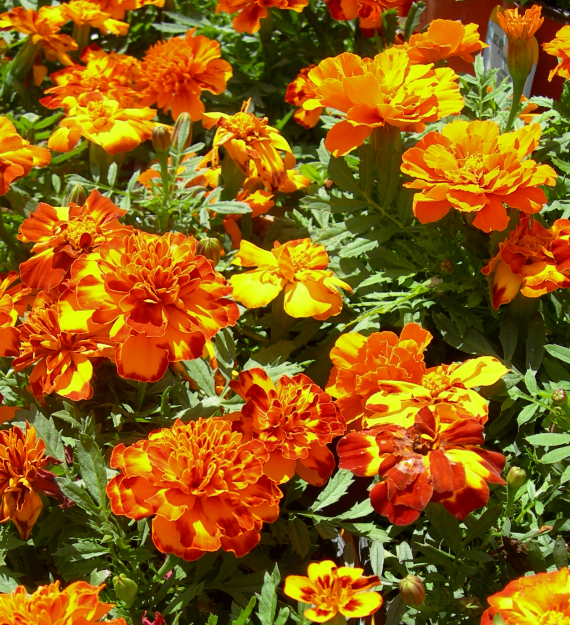
The first breath of cooler weather or blast of heat signals the transition times for gardeners in the tropics and sub-tropics. However, these changeover times can be difficult times to plant. The weather can be hot or cold, and there may be frequent heavy rains or days of dry weather, yet the occasional cool front blows through, dropping the temperature and humidity for a while. French Marigolds are an excellent and fun choice to plant as the weather changes.
Many gardeners transplanted to warmer climates remember marigolds as summer annuals in cooler climes. Although marigolds tolerate heat and cold well, they do not perform well in the high humidity, frequent rains of the Florida summer, or the occasional freeze in the winter.
An herbaceous annual grown for showy flowers, French marigolds are generally upright and branching with a small taproot. The leaves are opposite of each other on the lower part of the plant and alternate on the upper part. The leaves elliptical in shape with deep indentations, which make them appear pinnate or feather-like. Velvety to the touch and edged with serrations and oil glands, the leaves are strongly scented. I like the fragrance of marigolds.
Pretty little daisy flowers sit atop tubular stems; they are heads made up of many smaller blooms. There is a row of ray flowers with a large petal ringing the outside of the bloom head and disk flowers with much-reduced petals in the middle in single types of marigolds. Semi-double and double types have larger petals on both ray and disk flowers, making the flowers look like small chrysanthemums. Each bloom is from ½ inch to 2 inches across. Fruits, which follow the flowers, are small black achenes like tiny, thin sunflower seeds topped with brushy bristles which catch on animal fur for distribution.
French marigolds brighten any location where planted. They are suitable for beds, containers, and borders and are small mounding plants usually from 6 to 12 inches tall and 8 to 18 inches wide. Choose a location with full sun and well-drained soil that can be irrigated if the weather turns dry.
Plant them from small plants or seeds; they grow easily from either. Deadheading or removing old blooms encourages the formation of new flowers. Some landscape professionals prefer not to mulch annual beds to ease the constant changing of the plants. Still, the benefits of weed suppression, cooling of the soil, and water conservation are worth the trouble of pulling back mulch when replanting.
Even with the best care, marigolds are short-lived in the Florida garden. Plant marigolds as the weather changes, deadhead the flowers often and enjoy the plants for about 8 to 12 weeks. If the plants grow and bloom for more extended periods, congratulations!
French marigolds are valuable in the veggie garden. The flowers are edible, and the plants can reduce pesky nematodes. Edible flowers are a delightful and sensual addition to any meal. Treat flowers intended for the table as you would any veggie and use pesticides sparingly, according to the label, or not at all.
Research has shown French marigolds reduce some parasitic root nematode populations, namely root-knot and lesion nematodes. Marigolds must be planted thickly as a cover crop two months before the desired crop is installed to be effective as pest-reducing agents. Turn the marigolds under when the plants and blooms are lush and thick to decompose and turn into beneficial organic matter.
This column first appeared in the Treasure Coast Newspapers.
Leave a Reply